ALIEN INVASION
Rapid water lettuce spread threatens Vaal River — weevils could be the solution
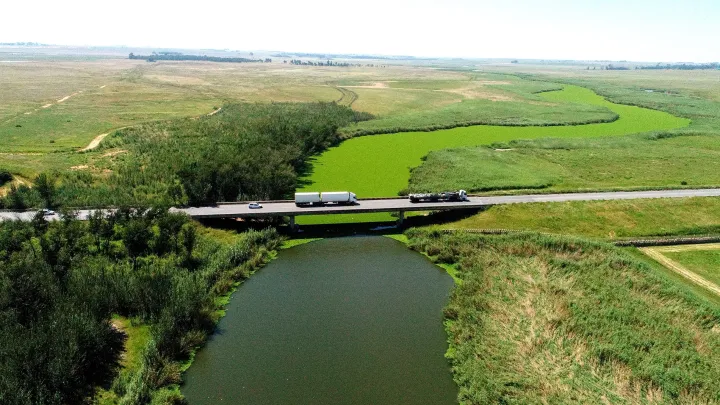
The Vaal community is scrambling to halt the spread of water lettuce, an invasive alien species threatening the Vaal River. There is a clear solution to deal with these floating plants, but a new regulation threatens to slow the process.
‘We have a very limited window of opportunity to urgently remove this water lettuce, which is currently very accessible,” said Rosemary Anderson, who has spent her whole life living alongside the Vaal River.
Water lettuce, an invasive species originating in South America, began to spread in the Taaibos — a small tributary stream that runs into the Vaal River — before being contained by a floating barricade erected by residents.
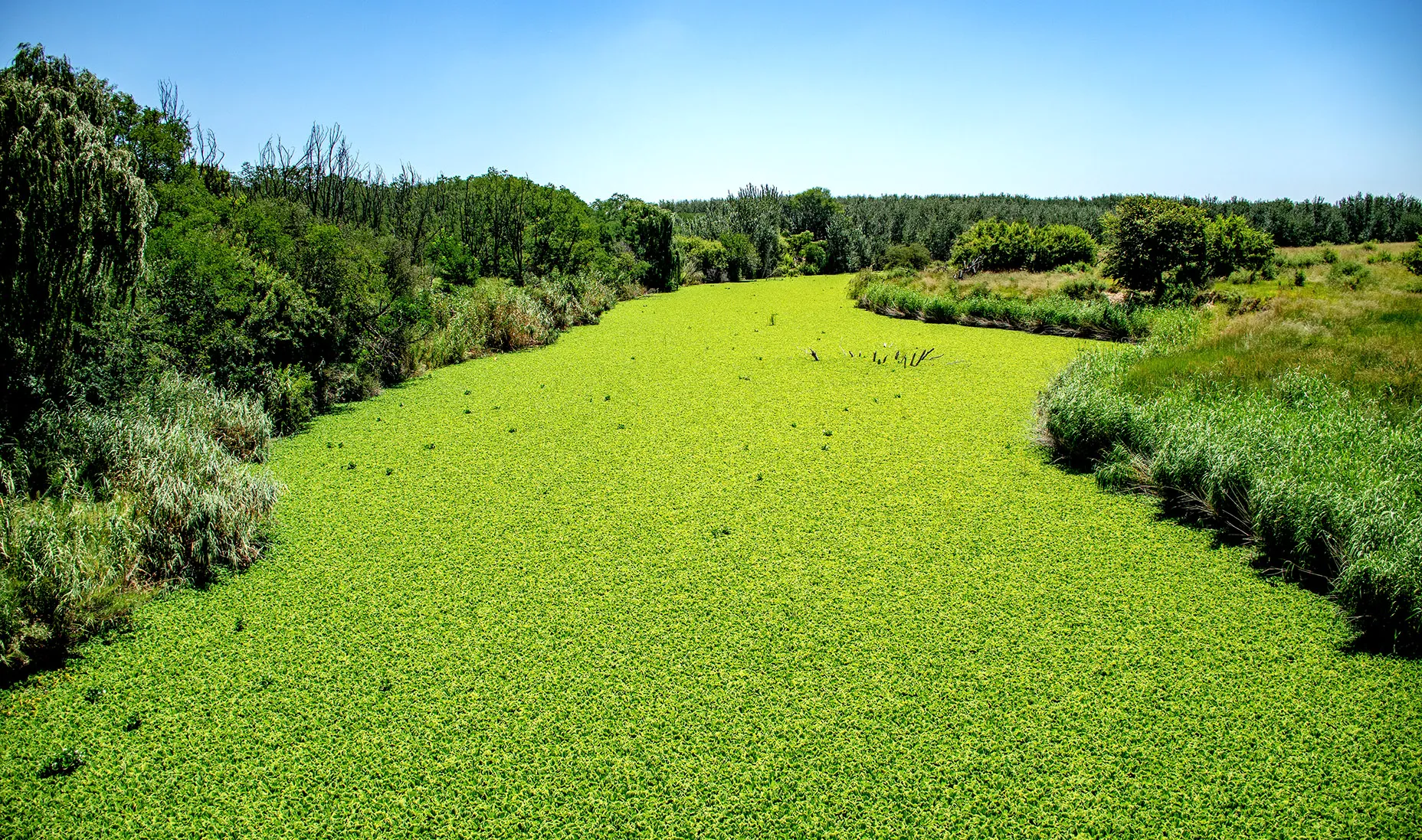
The Taaibosspruit (a tributary of the Vaal River) is inundated with alien invasive species, with water lettuce covering the stream for kilometres. (Photo: Julia Evans)
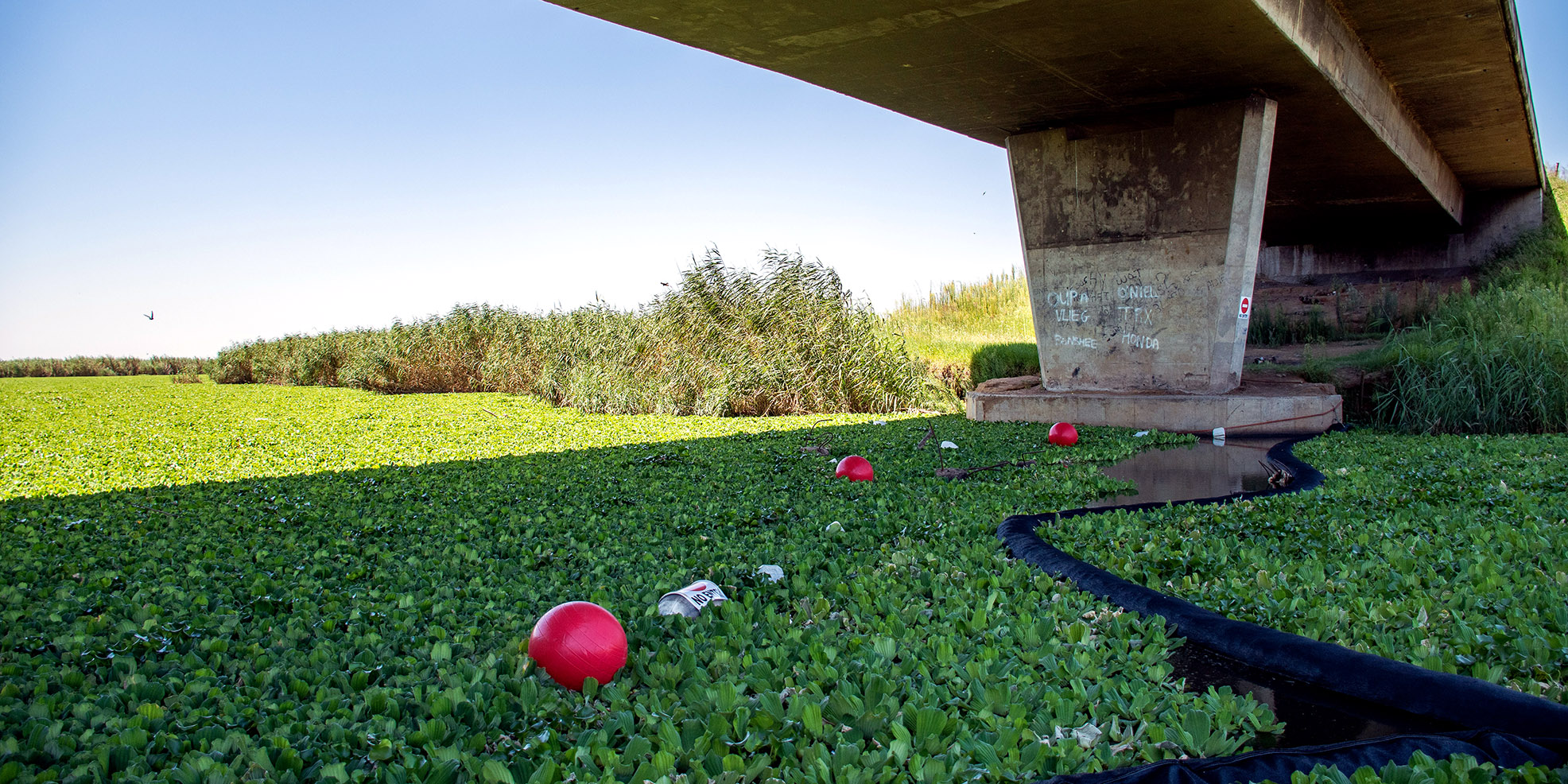
Vaal River residents have bottlenecked the spread of alien invasive species (water lettuce and some water hyacinth) on the Taaibosspruit, trying to stop the spread of the species into the Vaal River using a buoy system. (Photo: Julia Evans)
Before the barricade was put up, however, the plants floated into the Vaal River, and now span about 25km of the river, from the mouth of the Taaibos towards the Vaal Barrage.
“If this water lettuce is allowed to pass past the barrage, it then has a free journey of approximately 1,000km of middle and lower Vaal River, the Bloemhof Dam and then into the Orange River,” said Anderson, who owns the garden restaurant Stonehaven on Vaal and is the chairperson of the hospitality association Fedhasa.
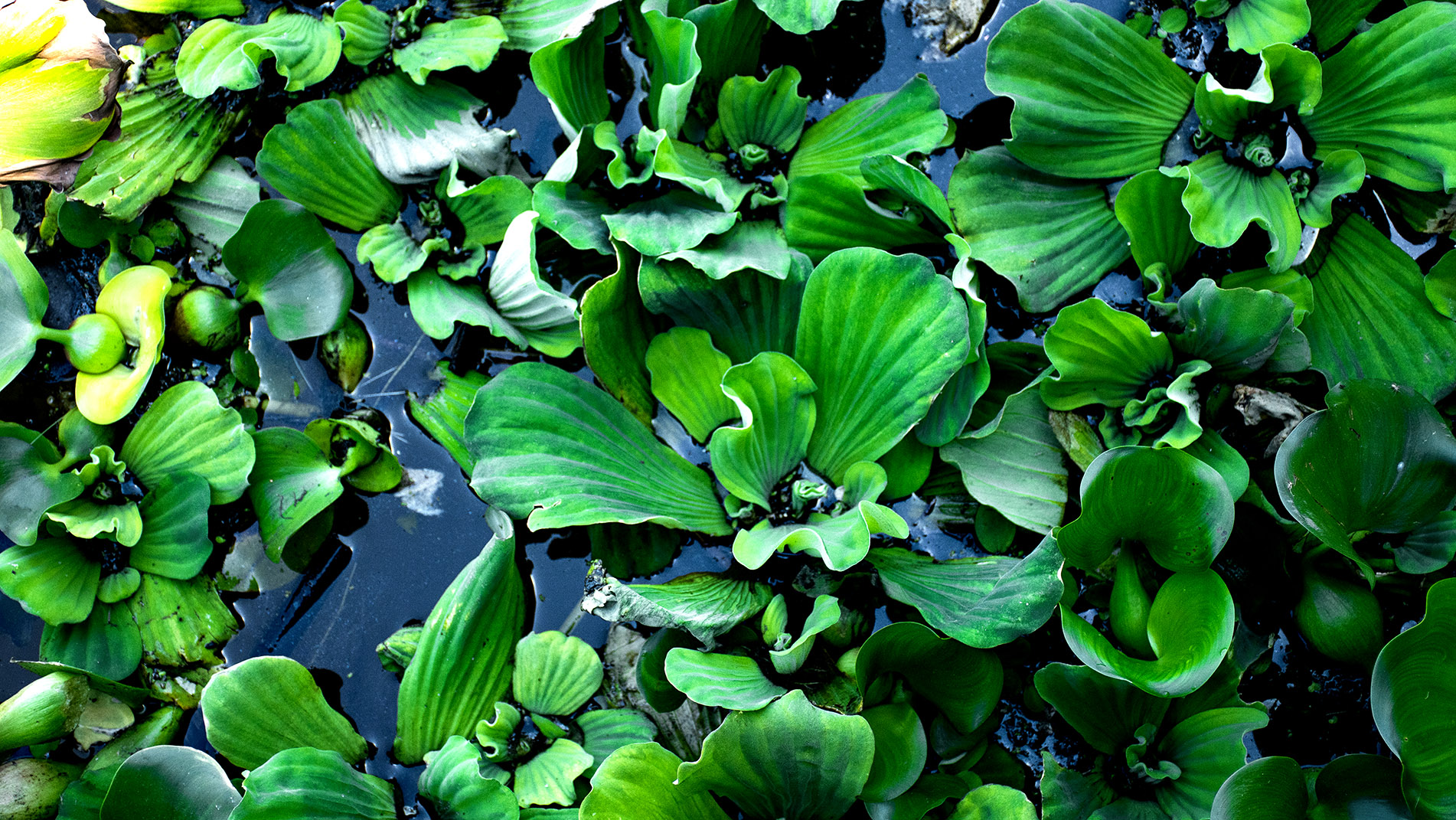
Water lettuce is an alien invasive species from South America. It can affect local water biodiversity, human wellbeing, business, tourism and the broader environment. (Photo: Julia Evans)
“Many towns, communities and farmers abstract from these waterways for both drinking water and irrigation. This will have a significant negative impact on them. That is why this is a national crisis,” Anderson said.
Anderson and her community began noticing water lettuce on the river in 2021.
Anderson emailed Rand Water, which said it was not its mandate.
Because the water lettuce died each winter, it wasn’t a huge concern. But this past summer, in December, residents reported a “dramatic change”, with water lettuce and water hyacinth coming down the Taaibos Spruit and moving into the main river.
“I do hope that the DWS [Department of Water and Sanitation] and Rand Water appreciate that time is of the essence and every day more water lettuce is flowing past the barrage and unnecessarily polluting downstream of us,” Anderson said.
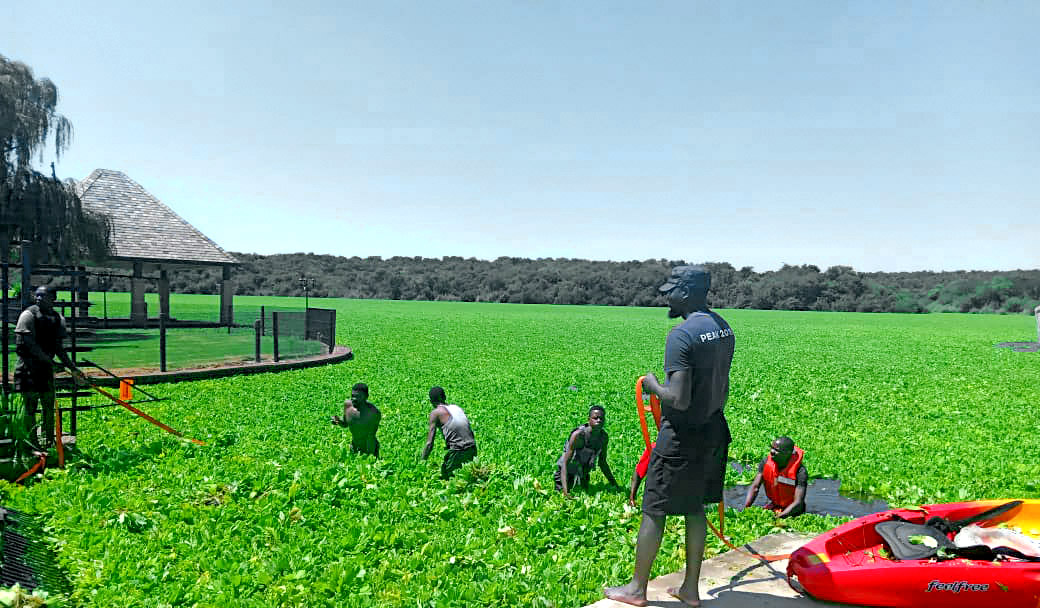
An extraction team manually removes water lettuce from the Vaal River at Malbank on 29 January 2024. (Photo: Laurel Young)
The Vaal River community has a WhatsApp group with more than 100 members, who have begun removing tonnes of water lettuce from the river.
The US University of Florida’s Center for Aquatic and Invasive Plants says, “Water lettuce forms dense mats that clog waterways making boating, fishing, and other water activities, impossible. These mats also degrade water quality by blocking the air-water interface and greatly reducing oxygen levels, which can result in fish die-off and the overall reduction of aquatic fauna and flora diversity.”
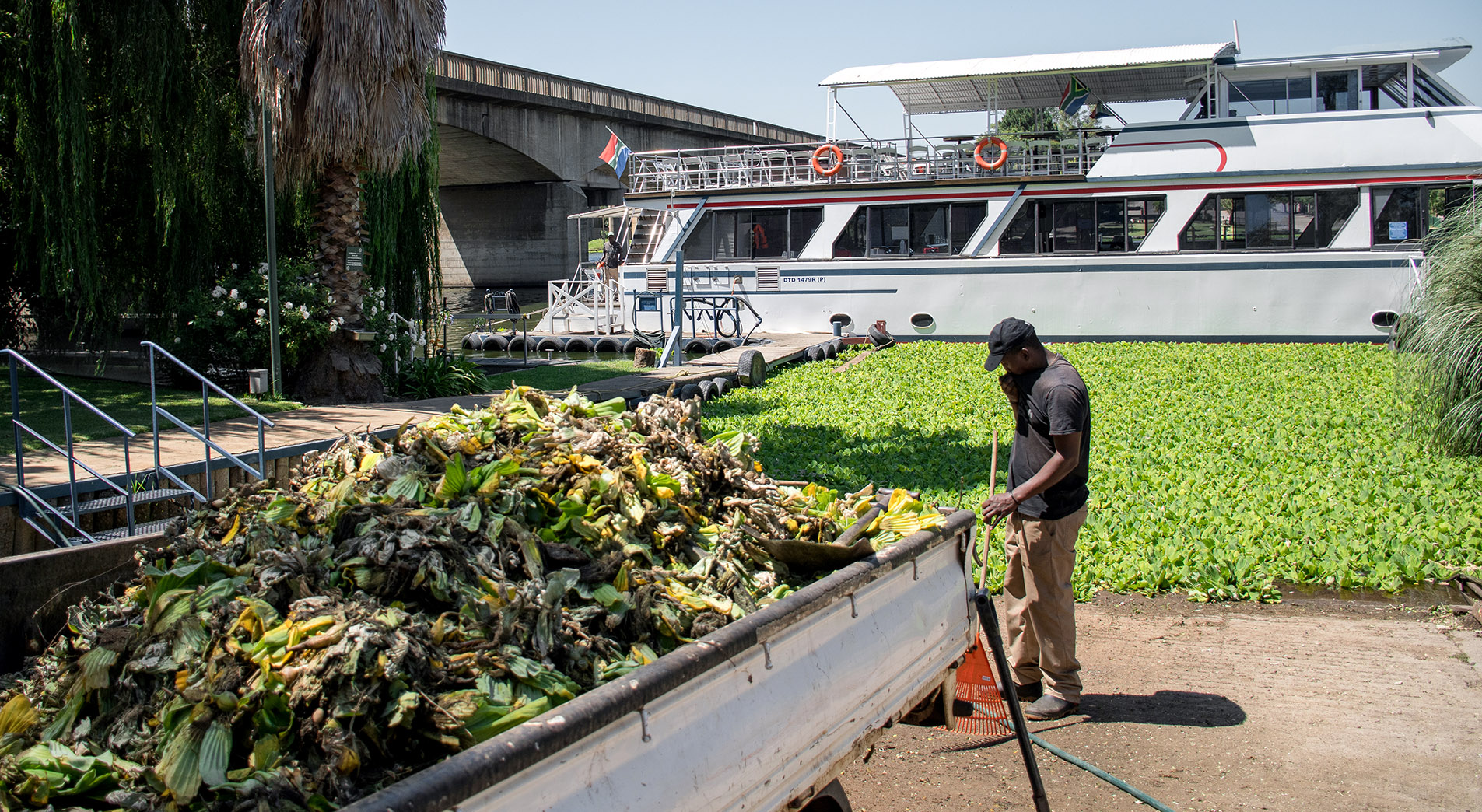
Residents along the Vaal River have been removing several tonnes of water lettuce a day from the river in an urgent attempt to stop the rapid growth of this invasive species. (Photo: Julia Evans)
Laurel Young, the owner of the Vaal River Lodge in Northdene, told Daily Maverick that she has a team that manually removes four 8-tonne truckloads of water lettuce a day.
Anderson came across the concept of biological control agents, which have eradicated aquatic invasive species like water lettuce across South Africa for decades.
She contacted Dr Julie Coetzee, the deputy director at the Centre for Biological Control at Rhodes University about the Vaal River problem.
Coetzee told Anderson that they had also approached Rand Water in 2021, when the water lettuce first appeared, to initiate a biocontrol, which uses insects or pathogens to control the growth of invasive species, but said that because of staff changes at Rand Water, the measure was not implemented.
The solution — weevils
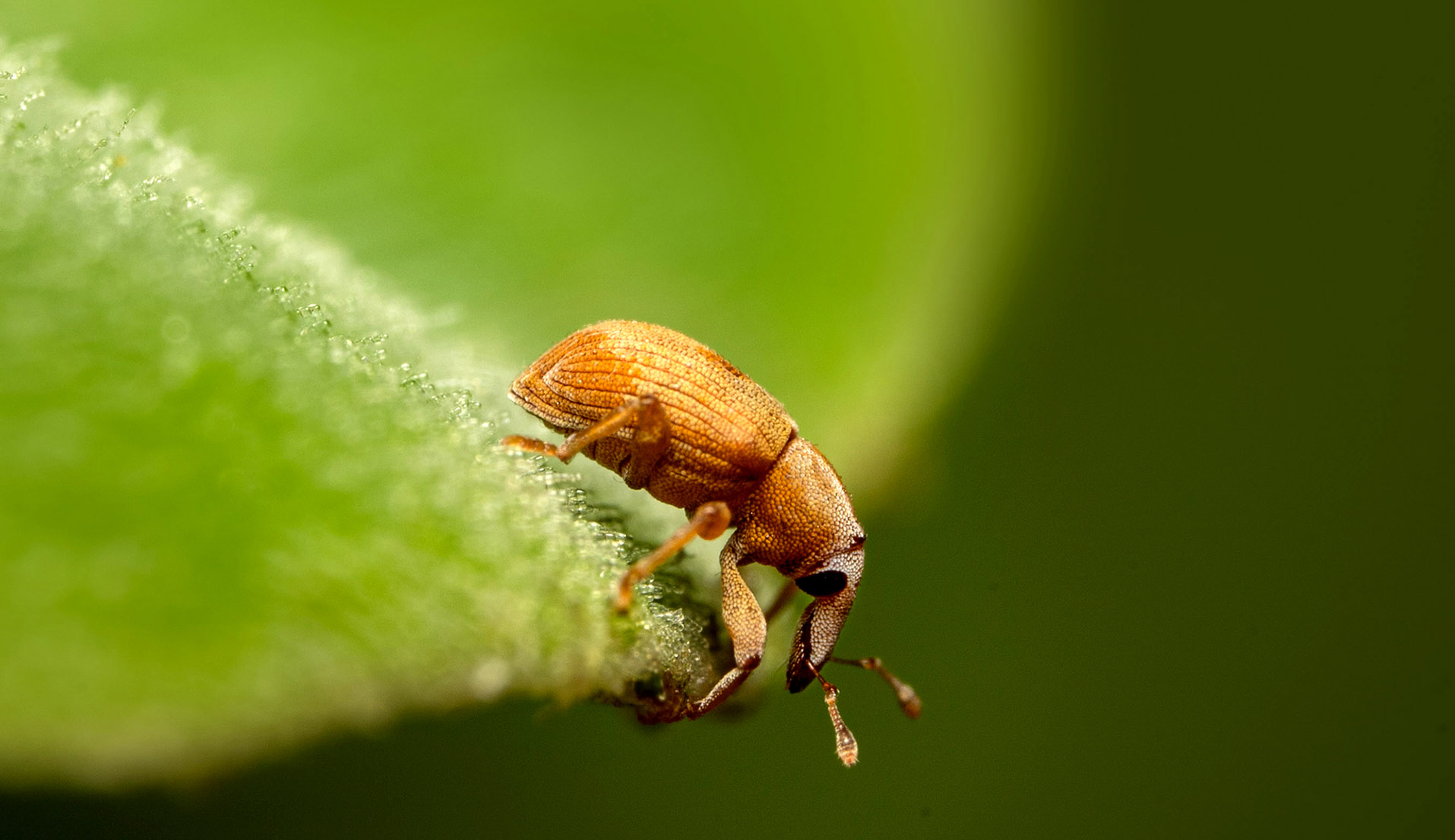
Water lettuce weevils can be used as biological control agents to control the expansion of the invasive plant species. (Photo: David Taylor / Centre for Biological Control)
“Water lettuce biocontrol is one of the best biocontrol programmes against invasive weeds in the world, but we need to ask people to be patient,” said Coetzee.
She explained that while manually removing plants from key areas, like boat access points, was possible, the plants’ growth rate was far too quick for this method to control the spread, and any plants left behind in inaccessible places would reinfest.
Biological control, in this case using water lettuce weevils, can lower the growth rate, reduce the size of the plants, and get into every nook and cranny where the plants are. Weevils feed on and tunnel into the leaves of invasive species, causing them to become waterlogged and sink.
Coetzee explained that specific species of weevil target only water lettuce, whereas the other two methods of dealing with aquatic invasive species, chemical sprays and herbicides, can kill anything living in the water after the plants sink, as well as bank vegetation and indigenous plants.
The biggest negative side of biocontrol is how long it takes.
“So you really have to convince people that this is the most sustainable option to get rid of [the water lettuce], with fewer side effects than any other control option,” Coetzee said. “In a world of instant gratification, we need to be patient.”
Coetzee said the insects’ reproduction and feeding rates would slow during winter and it would probably take two seasons for the weevils to eradicate the plants.
A tried and tested method of success
The Centre for Biological Control’s Sisonke Programme has successfully used weevils to control invasive species throughout SA and the method has also proved successful in other parts of Africa, Australia and the US.
At Hartbeespoort Dam, water hyacinth was controlled with “inundative release strategies”, whereby researchers help local people breed hyacinth insects on site and release them into the dam.
So, once the water lettuce weevils are sent to the Vaal, residents, along with Rand Water, will need to implement their own “rearing stations” to keep growing the insects.
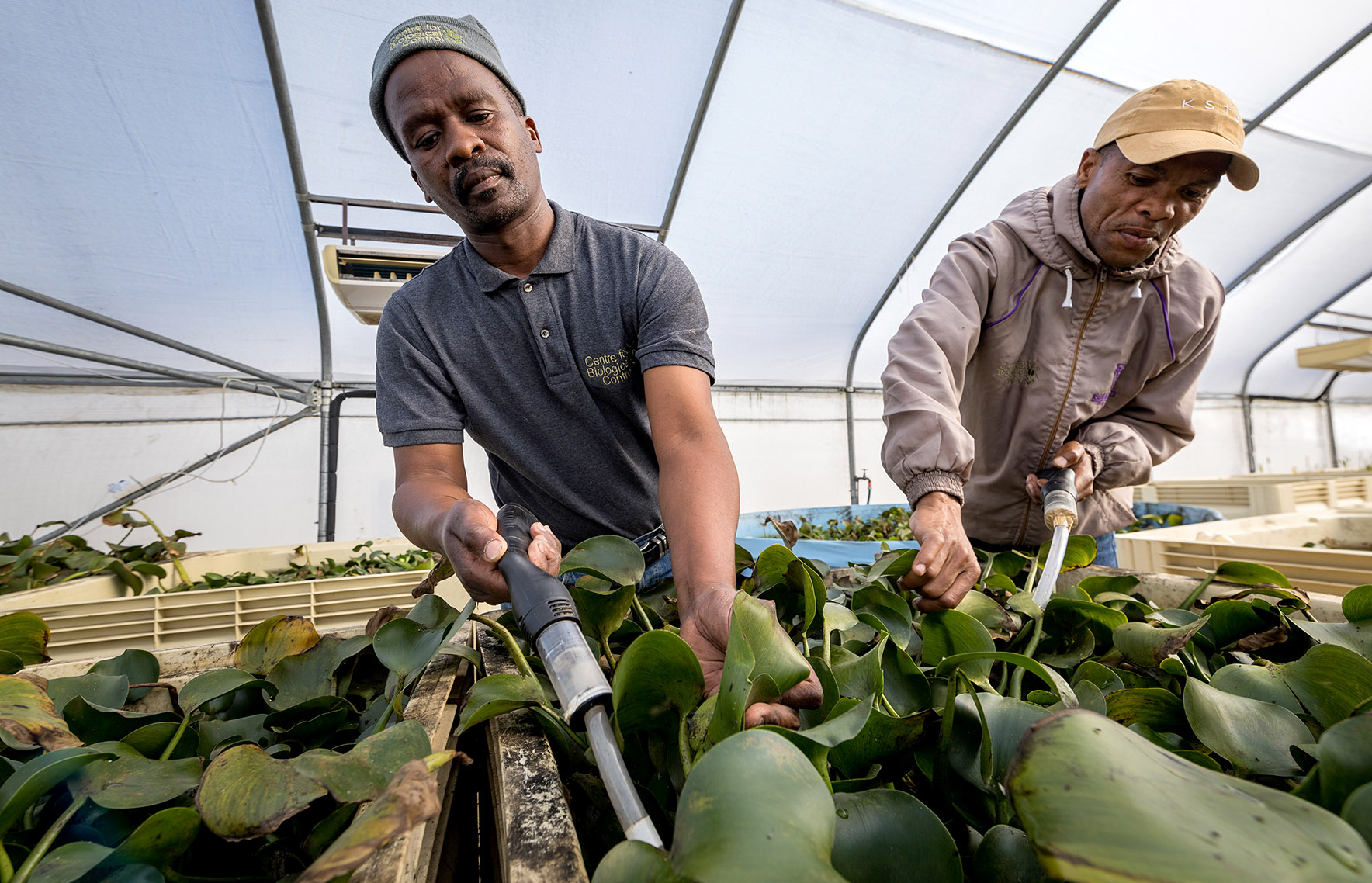
Employees, part of the Centre of Biological Control, at Rhodes University in Makhanda, work in the rearing station to breed weevils as biological control agents. (Photo: David Taylor / Centre for Biological Control)
“Instead of saying, ‘What’s the government doing about this?’, [people] can say, ‘Well, look what we’re doing about this,’” Coetzee said.
Rand Water told Daily Maverick they had identified a rearing station at one of its sites that allows for heating in winter, and would fund this part of the project.
Sasol, which has a chemical plant near the Vaal River, has approached Rand Water to explore opportunities to assist with the control of aquatic invasive plants.

The Centre for Biological Control Sisonke Programme employs 10 people living with disabilities from Makhanda to rear biological control agents (such as weevils). (Photo: David Taylor / Centre for Biological Control)
DWS spokesperson Wisane Mavasa told Daily Maverick, “A combination of biological control and chemical control is a more environmentally sound approach to dealing with these plants compared to chemical spraying only.”
She said the plants would be sprayed when the insect population reached 60-80% of the plant mass, explaining that spraying before this would lead to a toxic bloom.
New red tape
While the Centre for Biological Control helped community partners get permits from the Department of Forestry, Fisheries and the Environment (DFFE) to rear weevils on their property, they never had to apply for permission to release the weevils into the water — until new authorisation was gazetted by the DWS in December.
Rand Water told Daily Maverick that they had applied to the DWS for the necessary authorisation and had had several meetings with authorities.
“In the meetings [with the community] the urgency of the application has been stressed. Rand Water awaits a response from DWS on the agreed approach to take, and will then complete the necessary risk matrixes, studies and documents,” Mbuyiswa Makhubela from Rand Water said.
“If this was deemed a national emergency — which it is — then surely immediate action could be taken,” Anderson said.
“We are talking weeks, or maybe months [until biological control can be implemented] if this bureaucratic process is followed.”
Who’s responsible?
While more than 100 people on the Vaal River are willing to tackle this issue in pursuit of saving the river they love, whose responsibility is it?
The answer is tricky, Coetzee said. The DFFE should be the one controlling invasive species because its Working for Water programme originally funded biological control.
The DWS said it had a memorandum of agreement with the DFFE to ensure control of aquatic invasive species.
At the end of 2023, DFFE Minister Barbara Creecy launched a R2.6-billion programme for the manual removal of terrestrial (land-based) invasive species.
Read more in Daily Maverick: Creecy launches R2.6-billion invasive species programme — experts say more funding needed in critical areas
Coetzee said removing aquatic plants manually would be “a waste of time and money because they just keep growing. You remove a hectare today, and tomorrow it’s back because of the rate at which these plants grow.” Biological control would be a better investment.
Dr Brian van Wilgen, an ecologist and emeritus professor at the Centre for Invasion Biology at Stellenbosch University, agreed: “If you were really serious about the problem, I would spend 10-30 times more on biological control than you are because it holds so much promise.”
Rhodes University’s Centre for Biological Control previously had a contract with the DFFE to implement biological control programmes across South Africa. DFFE spokesperson Michael Mokoena told Daily Maverick that the contract had expired in 2021 and a new tender was initiated.
The Centre for Biological Control wasn’t awarded the tender, but its application is still in the mix.
Mokoena said the DFFE does have a programme for the release and monitoring of biocontrol agents in South Africa, including the Vaal River, but Vaal residents say it hasn’t implemented a programme to combat the water lettuce.
As the land owner of the Vaal Barrage, Rand Water also has a responsibility to control invasive species, and said it is engaging with the Centre for Biological Control and the DFFE “to ensure that the introduction and release of biocontrol agents is undertaken as soon as possible”.
The problem below the surface
Professor Anthony Turton, a water resource management specialist at the University of Free State, told Daily Maverick that while biological control was a good solution to get rid of invasive species, it was akin to treating a symptom while ignoring the underlying illness.
Turton said aquatic invasive species were expanding at such a rate because of water eutrophication, which is the “explosive growth of microorganisms, to the extent that dissolved oxygen is depleted”. This created an ideal environment for plants such as water hyacinth and water lettuce to grow.
Dr Samuel Motitsoe, an aquatic ecologist based at Wits University, said water eutrophication was a serious concern for human and wildlife health and aquatic biodiversity. He believed the combination of untreated raw sewage and agriculture run-off was causing the high level of nutrients in the Vaal River.
The DWS agreed, adding that along with sewage and agriculture, run-off from informal settlements, illegal discharge of waste and industrial processes contributed to the eutrophication of water.
“The problem is extremely big in South Africa and prevalent in 80% of the dams in RSA,” Mavasa from DWS said.
Nearly two-thirds (64%) of South Africa’s sewage and wastewater treatment works are at “high or critical risk” of discharging partially treated or untreated water into rivers and the environment, according to the latest Drop reports from the DWS, published in December.
Three wastewater treatment works — Reitspruit, Sebokeng and Leeuwkuil — in Emfuleni discharge effluent into the Vaal River and its tributaries.
While the functioning of these three plants has improved slightly since DWS appointed Rand Water to manage, upgrade and repair them in January 2022, none is up to scratch. As the regulator said in the 2023 Green Drop report, “All three works have poor quality effluent which negatively impacts downstream communities and the receiving environment.”
This means that dealing with the invasive plants will not solve the problem of the eutrophicated water. A further problem is that removing the floating plants that are blocking the sun will cause the proliferation of cyanobacteria, which has toxins that can cause respiratory illnesses.
“It’s a wicked problem,” agreed Coetzee, saying that first and foremost, water quality needed to be improved.
The DWS said they had a eutrophication strategy to improve water quality, had reintroduced the Green Drop report to identify key deficiencies and had initiatives to increase plant capacity. DM


















 Become an Insider
Become an Insider
The lesser of two weevils I hope.
(boom boom)
Clearly treat the underlying cause urgently. But I doubt very much that anything will change as there is not only any political will but some BIG businesses that caused the problem as also unwilling to change their processes.
I know nothing about this ———BUT —- when we were in Myanmar a few years ago , they grow water hyacinths , for fertilizer. ! Why can we not do the same here ?
The ANC Government again….add this to roads, ports, roads, water, sewage
Just do it… as we have had to do with solar power, homeless traffic light management, water storage, private security, private healthcare and private schools. The ANC run DWS aint gonna do sweet fanny Adam’s..
Semera, Flumigard and Dibrox with manual removal of dead material thereafter the only sollution. Nice job creation with biomass can be sold as mulch or compost. Email me [email protected].
If one evaluates the waterboards nationally, a commonality is soon apparent. Gross dereliction of duty combined with a high handed cadre mentality. Water tankers and local governance in an unholy alliance. Officials needing body guards tells us there is contestation at the feeding trough!
What is it that these people don’t get? Lettuce and hyacinth are symptoms of excessive nutrients,like nitrates and phosphates. With the weed gone, sunlight will reach the water and blue green algae will form. Now that is toxic. https://scarabsa.co.za/index.php/blog/harties-hyacinth
“Anderson emailed Rand Water, which said it was not its mandate.”
“Instead of saying, ‘What’s the government doing about this?’, [people] can say, ‘Well, look what we’re doing about this,’” Coetzee said.
“Who’s responsible?”
And all the time they spend discussing who’s responsible, the water lettuce keeps spreading😡
A very interesting article and hopefully the red tape will not impede the process and progress of irradiating this alien species but as other projects in SA the bureaucracy will take too much time and effort and nothing will change or happen. So sad !!!